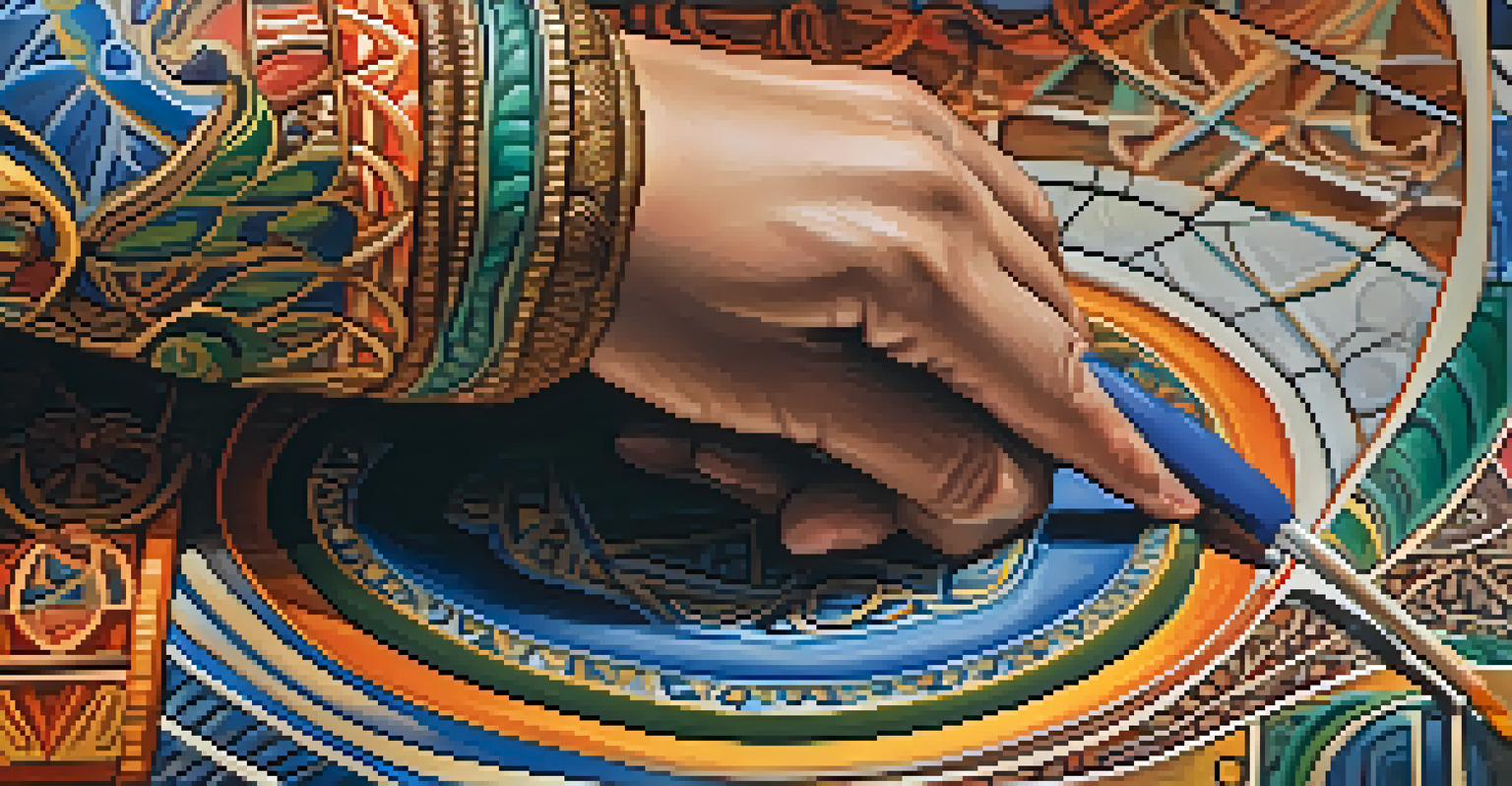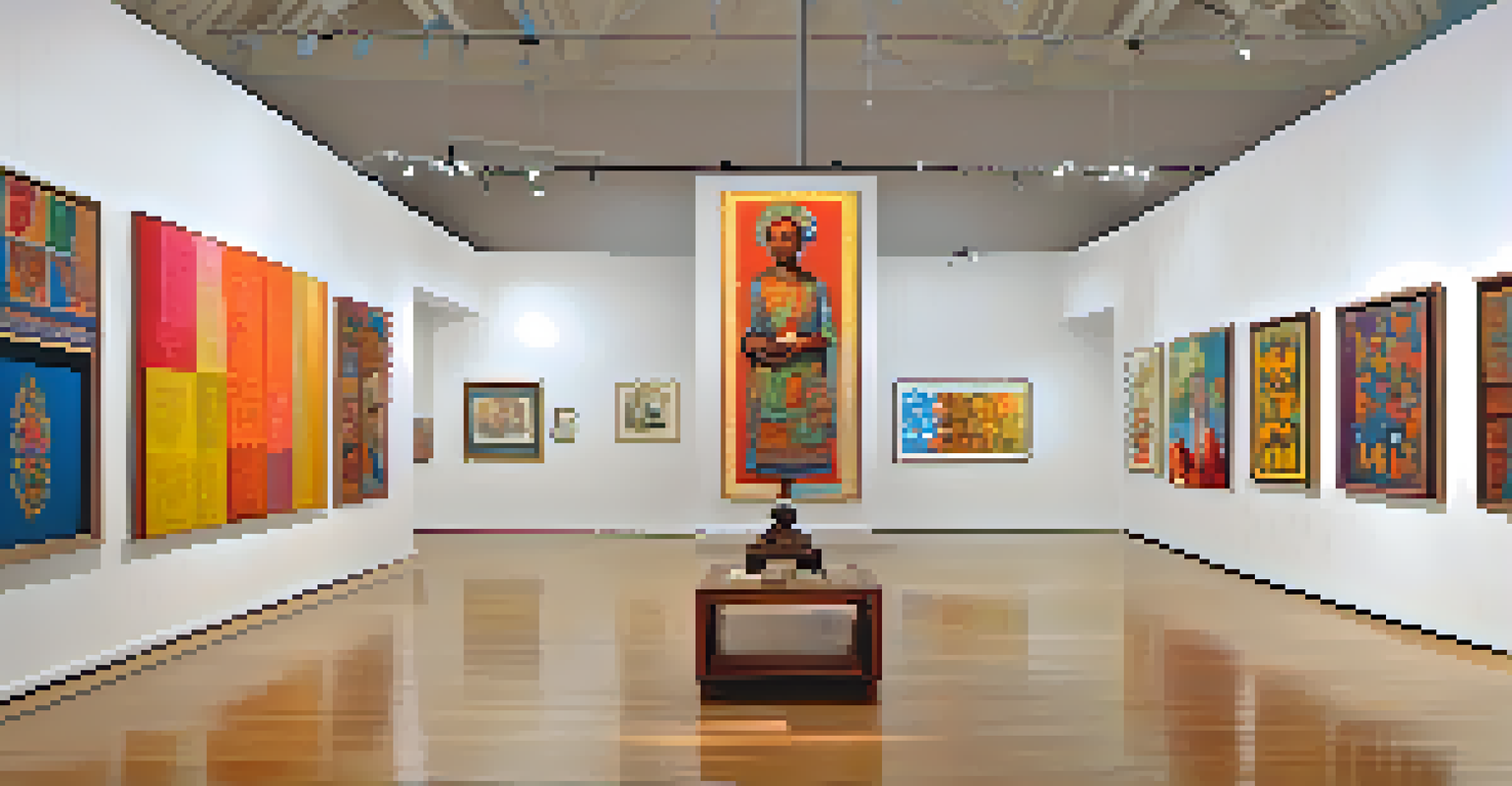Art as a Reflection of Folklore: Cultural Narratives Explored

Understanding the Connection Between Art and Folklore
Art and folklore are intimately connected, with each reflecting the other. Folklore encompasses the traditions, myths, and stories passed down through generations, while art serves as a visual interpretation of these narratives. When we engage with art, we often find ourselves exploring the cultural identities and historical contexts that shape these stories.
Art is the most beautiful of all lies.
For example, a painting depicting a legendary hero can evoke the values and struggles of a specific culture. Such works not only tell a story but also preserve the essence of the community's beliefs and practices. In this way, art becomes a vessel for storytelling, connecting viewers to the past.
Moreover, folklore often inspires art, leading to a rich tapestry of creative expression. Artists draw upon the symbols, themes, and characters found in their cultural narratives, allowing them to reinterpret and reimagine these tales through their unique lenses.
Cultural Identity and the Role of Art
Art plays a crucial role in expressing and preserving cultural identity. Through the visual representation of folklore, artists can convey the spirit and values of their communities. This connection helps individuals and groups maintain a sense of belonging and continuity amidst an ever-changing world.

Take, for instance, Indigenous art that often incorporates traditional stories and symbols. These artworks serve as a reminder of cultural heritage, showcasing the deep-rooted connections to the land and ancestors. By engaging with such art, viewers gain insight into the distinct narratives that shape these communities.
Art Reflects Cultural Identity
Art serves as a powerful medium to express and preserve the unique cultural identities and narratives of communities.
Furthermore, the celebration of cultural identity through art can foster appreciation and understanding among different groups. As people interact with diverse artistic expressions, they can learn about the stories and experiences that may be vastly different from their own, promoting empathy and respect.
Folklore Themes in Contemporary Art
Contemporary artists often reinterpret folklore themes, bridging the gap between past and present. By infusing traditional narratives with modern techniques and perspectives, they create a dialogue that resonates with today's audiences. This fusion allows for a deeper exploration of cultural relevance in an ever-evolving society.
Folklore is the living expression of the culture of a community.
For example, an artist might create a multimedia installation that juxtaposes ancient folklore with current social issues. This approach not only highlights the enduring nature of these stories but also encourages viewers to reflect on their significance in contemporary life. Such works can spark conversations about identity, heritage, and the challenges faced by cultural communities.
Additionally, the revival of interest in folklore within the art world can inspire a new generation of creators. By embracing their cultural narratives, these artists contribute to the ongoing evolution of folklore, ensuring that it remains a vital part of the artistic landscape.
The Impact of Art on Cultural Narratives
Art has the power to shape and influence cultural narratives. Through visual storytelling, artists can challenge prevailing stereotypes or misconceptions, offering alternative perspectives that enrich the understanding of a culture. This transformative potential can lead to greater appreciation and recognition of diverse narratives.
Consider how art movements have historically responded to social issues, such as the Harlem Renaissance, which celebrated African American identity through various art forms. These expressions not only reflected the culture's struggles and triumphs but also contributed to a broader dialogue about race and identity in America.
Folklore Inspires Modern Art
Contemporary artists reinterpret folklore themes, blending traditional narratives with modern perspectives to engage today's audiences.
In this way, art becomes a catalyst for change, sparking discussions that can alter perceptions and promote inclusivity. By utilizing folklore as a foundation, artists can craft narratives that resonate with audiences, encouraging them to look beyond surface-level understandings of culture.
Preserving Folklore Through Artistic Expression
Art serves as a crucial tool for preserving folklore, ensuring that cultural narratives are not lost to time. Through various mediums—be it painting, sculpture, or performance—artists can capture and convey the essence of their heritage. This preservation is vital in a globalized world where distinct cultural identities often face dilution.
For instance, oral traditions may be at risk of fading away, but when artists depict these tales through visual art, they breathe new life into them. By translating stories into tangible forms, they create lasting impressions that can educate future generations about their roots.
Moreover, collaborative projects that involve community members can further solidify the bond between art and folklore. Such initiatives allow for the sharing of stories and techniques, fostering a collective sense of ownership over cultural narratives and ensuring their continuity.
Art as a Bridge to Understanding Diverse Cultures
Engaging with art that reflects folklore can serve as a bridge to understanding diverse cultures. By experiencing these artistic interpretations, people from different backgrounds can gain insights into the values and beliefs that shape various communities. This exposure fosters a sense of curiosity and respect for cultural differences.
For instance, a gallery showcasing artworks inspired by global folklore can invite visitors to explore stories they may have never encountered before. Such experiences encourage cross-cultural dialogue, allowing individuals to connect on a deeper level through shared human experiences found in these narratives.
Art Fosters Cross-Cultural Understanding
Engaging with folklore-inspired art promotes empathy and appreciation for diverse cultures, bridging gaps between different communities.
Ultimately, art becomes a shared language, transcending barriers and uniting people through the stories that shape their identities. This connection can lead to greater appreciation of the rich tapestry of human culture, promoting a more inclusive and harmonious world.
The Future of Art and Folklore in a Globalized World
As we move forward in an increasingly globalized world, the relationship between art and folklore continues to evolve. With the rise of digital platforms, artists have unprecedented opportunities to share their cultural narratives with a wider audience. This democratization of art can lead to a richer exchange of ideas and stories.
However, it also presents challenges, as the commercialization of culture can dilute the authenticity of folklore. Artists must navigate this landscape carefully, balancing the desire for exposure with the need to honor the traditions they represent. By doing so, they can ensure that their work remains rooted in cultural authenticity.

Looking ahead, the future of art and folklore will likely involve ongoing collaborations between artists and communities, fostering a deeper understanding of cultural narratives. As we celebrate this intersection, we can look forward to a vibrant artistic landscape that continues to reflect and enrich our shared human experience.